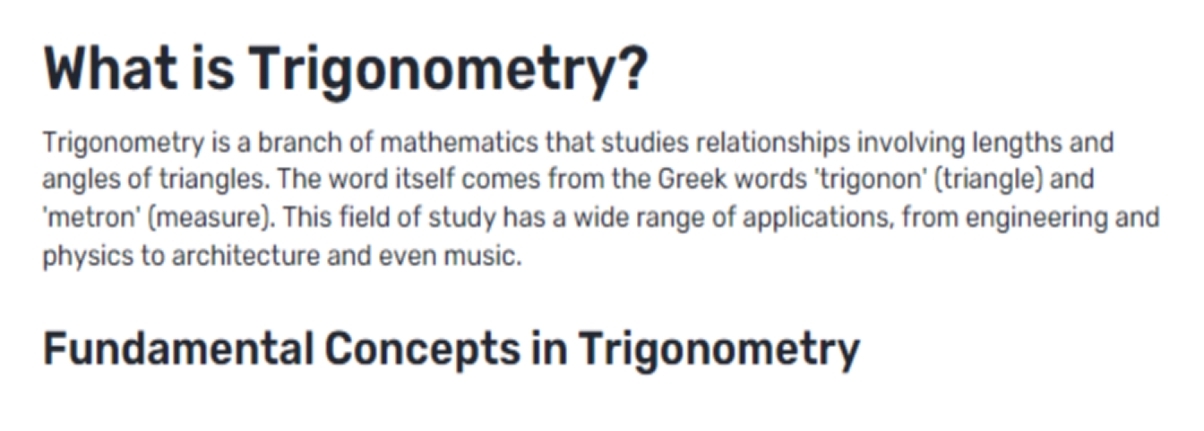Trigonometric identities are fundamental apparatuses in the realm of math, especially with regard to working on expressions and settling conditions including mathematical capabilities. By getting and applying these identities, mathematicians can control complex geometrical expressions to make estimations more sensible.
We will investigate the different manners by which Trigonometric identities can be used to improve expressions and tackle conditions. We will dig into What is Trigonometry and the essential characteristics that structure the premise of geometry, as well as further developed identities that are obtained from these fundamental standards.
What Are Trigonometric Identities?
Trigonometric identities are a bunch of conditions including mathematical capabilities that are valid for all upsides of the factors. In less difficult terms, they are numerical connections that interface the points and side lengths in a right-calculated triangle. These identities are extraordinarily valuable in working on mathematical expressions and addressing geometrical conditions.
One of the most generally utilized Trigonometric identities is the Pythagorean character, which relates the sine and cosine capabilities. It expresses that sin^2θ + cos^2θ = 1, where θ addresses a point in a right-calculated triangle. This personality is derived from the Pythagorean hypothesis, which expresses that in a right triangle, the square of the hypotenuse is equivalent to the amount of the squares of the other different sides.
Another significant geometrical character is the twofold point personality, which relates the sine and cosine elements of twofold the point to the sine and cosine elements of the actual point. Moreover, there are a few other Trigonometric identities that include different geometrical capabilities like digression, cotangent, secant, and cosecant.
Solve Expressions Using Trigonometric Identities
Trigonometric identities can be amazingly helpful with regard to working on complex expressions and settling conditions including geometrical capabilities. By utilizing these identities, you can change apparently confounded expressions into more straightforward structures that are simpler to work with. In this segment, we will stroll through the means associated with settling expressions utilizing Trigonometric identities.
Distinguish the Expression
The most vital phase in improving on an articulation utilizing Trigonometric identities is to recognize the articulation that you really want to work with. This might include spotting normal mathematical capabilities like sine, cosine, digression, secant, cosecant, and cotangent inside the articulation.
Select an Appropriate Identity
Whenever you have distinguished the geometrical capabilities inside the articulation, the subsequent stage is to choose a proper mathematical personality that can assist with improving the articulation. There is a wide assortment of Trigonometric identities, like Pythagorean identities, twofold point identities, aggregate and contrast identities, and item-to-aggregate identities, among others.
Work on the Expression
Whenever you have applied the Trigonometric identities and made the important replacements, the subsequent stage is to improve the articulation further. This might include working on parts, joining like terms, dispersing variables, or performing other mathematical controls to smooth out the articulation.
Address the Condition
As well as improving on expressions, Trigonometric identities can likewise be utilized to tackle conditions including geometrical capabilities. To do this, follow similar strides as framed above for working on expressions, yet with the additional objective of confining the variable and tracking down its worth. By applying trigonometric identities decisively, you can settle mathematical conditions proficiently.
Steps to Use Gauth to Solve Complex Questions
Gauth is a helpful resource that can help you with obtain results quickly and capably. By following several direct advances, you can without a doubt investigate through the stage to get the information you truly care about.

Stage 1: Open Gauth
To begin, you'll have to open the Gauth on your program. Basically type in the URL or snap on the bookmark if you've saved it for straightforward access. At the point when you're on the presentation page, you'll see a request bar where you can enter your query.
Stage 2: Enter the Query
Then, enter the watchwords or subjects you're enthusiastic about investigating. Gauth has a colossal informational index of information, so feel free to be basically essentially as unambiguous or wide as you'd like with your request terms. The more nuances you give, the more accurate your results will be.
Stage 3: Get the Solution
Right after entering your query, hit the enter key or snap on the pursuit button to begin the chase. Gauth will then, channel through the informational index to find huge information that matches your query. Depending upon the complexity of your case, this collaboration could require several minutes to two or three minutes.
Closing Thoughts
Trigonometric identities are amazing assets that can be utilized to improve complex expressions and tackle conditions in geometry. By perceiving and applying these identities, we can change convoluted issues into additional sensible structures, making it simpler to work with geometrical capabilities and conditions.


